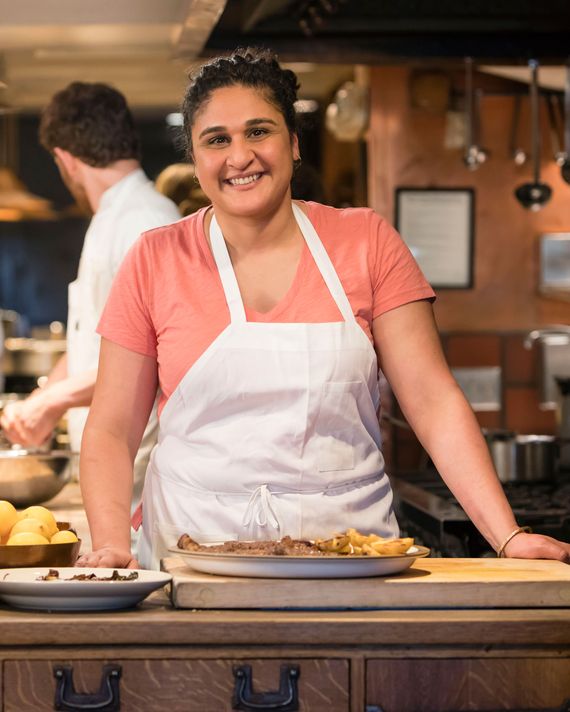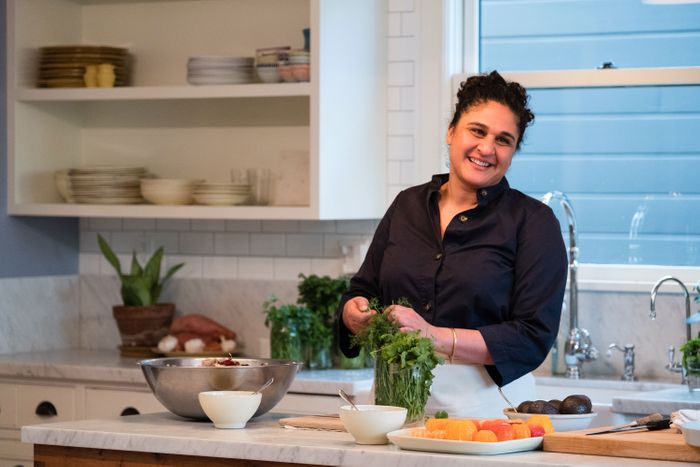
A blizzard of salt falls from Samin Nosrat’s hands into the vapor drifting off a boiling pot of water: handful after handful, grains blurring as they cascade down. “People freak out when they see how much salt it takes to properly season water, but you have to remember, most of that water is going to go down the drain,” the James Beard Award–winning author of Salt, Fat, Acid, Heat says in a voice-over.
Then she dips a spoon in and tastes the water.
“Okay!” Nosrat says, her eyes pinching together. “Once it’s salty enough to make you make a face like that, then it’s salty enough.”
Teaching people things like when the water is truly salty enough is why Nosrat’s new four-part Netflix series, which premieres October 11, exists. “The main goal for the show as a whole, absolutely,” she says, “is to convey the message that anybody can cook.”
Nosrat’s best-selling book isn’t a typical cookbook; it’s a resource that’s infused with expertise and personality. The show takes a similar approach. Salt, Fat, Acid, Heat is Netflix’s first how-to cooking program, but Nosrat’s lessons are so seamlessly integrated into the now-familiar luxury language of Netflix’s food travelogue shows — dreamy shots of sunset over fields in Italy, waves crashing onto a beach, an artisan lovingly crafting what looks like the best soy sauce ever made — that you might not notice that the host has transitioned into actionable advice.
“What I’ve seen my whole life — on PBS, on the Food Network, and most regular American cable shows, those 30-minute cooking shows — is a lot of cooking that is meant to be really instructive and practical, and accessible for people,” Nosrat says, citing Julia Child, Alton Brown, Martin Yan, and Emeril Lagasse among her own influences.
There are how-to cooking shows on TV (Ina Garten is still laughing while she adds more butter on Barefoot Contessa), but those kinds of instructional shows have largely been overtaken by reality competitions and travel shows, first on cable TV and now on Netflix. Nosrat loves those cinematic documentary-style shows, but says she felt like there was something missing.
Netflix’s Chef’s Table, she says, “changed the genre. It showed us what food TV could look like and could be like,” and that a show could be “so inspiring and so beautiful.” But “for basic home cooking, it’s really aspirational more than it is instructional,” she adds. “So I kept thinking to myself, Why can’t I have a show that’s beautiful with incredible cinematic style with the beautiful filmmaking that gets this sensory inspiration across, but also serves to be accessible? To teach you and to make you feel when you’re done watching, you can go in the kitchen and do something now.”
Salt, Fat, Acid, Heat was filmed last winter, with about ten days dedicated to each of its four chapters, but the idea for a television show predates Nosrat’s book by about a decade. In 2007, she taught her third cooking class and realized that the format was holding her back. “I was talking to two other chefs who taught me how to cook,” she says. “I was like, ‘You guys, I think this is too slow. I think what I need to do is have a TV show where I teach people how to cook because then it’s just going to be so much more efficient.’”
How Nosrat actually imparts information to viewers varies from scene to scene, episode to episode. She’s not emulating Julie Child by talking directly to the camera and thus to viewers. Instead, the few times she demonstrates a technique alone in the kitchen, she’s actually addressing an off-camera producer. In other scenes, she’s joined by someone — a friend, an expert, or in the “Heat” episode, her mother — who can serve as a surrogate audience member.
“Heat” is the episode that devotes the most time to “straightforward lessons,” she says. Finding the balance between learning and demonstrating, showing and telling, was trial and error, even for a four-episode show. “I think as we went along, we were just trying to figure out what was landing and working the best,” Nosrat says. “I like having a person there because I really feed off of people. I love learning from them.”
Part of what Nosrat hopes to do with the series is chip away at the culture of shame that’s arisen from TV and social media. “I find a lot of home cooks being really hard on themselves because they’re not making really complicated stuff that looks perfect on Instagram, that has seven elements in the salsa verde or whatever. You’re like, ‘Dude, just squeeze a lemon over it. It’s not that big of a deal; you don’t have to do this whole production for your dinner on Tuesday.’”
Still, her show is beautifully composed and artfully shot. (It’s produced by Jigsaw Productions, which also produced Michael Pollan’s Netflix series Cooked.) Salt, Fat, Acid, Heat explores its four fundamental ideas in Japan and Italy, Yucatán and Berkeley, and the cinematography makes those places and people look as gorgeous as they do melting pats of butter. But Netflix executives kept Nosrat and the producers focused on her teaching. “Any time we started getting too excited about, like, ‘We want to go visit this place,’” Nosrat says, “they were just like, ‘Remember, this is not a travel show. This is a cooking show.’”





